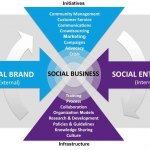How to Improve Social Media Performance with Multivariate Testing
The role of A/B testing and optimization is not often discussed in social media. With so much focus on content, timeliness, and channel management, it’s often difficult to articulate a clear testing strategy, and most of the time, social media managers don’t have any ability to test messaging because they don’t control the channel – it’s impossible to measure the impact when you can’t see behind the curtain to understand what’s going on.
But, the social elements of your website are an area where multivariate testing is possible. And the results can be applied across your entire social media strategy. Testing should be a fundamental part of the on-site social media plan.
Of course, there are a number of best practices that we already know about social login and other social interactions. However, the specific ways in which your users interact with your brand and the experiences you have created on your website will vary dramatically. Best practices help deployments go smoothly and efficiently, but they can’t maximize performance – only your users can tell you what works best for them. That means that testing and optimization of the social elements on your site is critical.
We have seen simple A/B testing improve performance of social elements by 2-3x in just a matter of weeks. The reason that testing is so effective is that it allows users to make the decisions, and sometimes the preferences of the user are a surprise, even to marketing teams who know their customers well.
In considering how to structure a series of multivariate tests for social components, it’s important to start with a clear vision of what metrics you are trying to impact. Frequently, we see that deploying tracking has an immediate impact on the number of registrations on a website. If driving registrations is a clear goal, testing variables in the registration process is a natural next step after deployment.
Consider testing elements in the social login process like:
Identity providers: This is one of the easiest elements to test. Consider both the identities you offer, and also the placement and prioritization of identity providers. You will want to align with your overall business goals, of course, so some identity providers may not be relevant, but you may be surprised where you find pockets of interest and activity with focused identity providers.
Here we see two typical setups of identity providers for different sites. The first is for a retail site, and the second is for a community site. Notice how the identity providers are prioritized differently.
Size and emphasis: Social login can be prioritized strongly, or weakly; it can sit alongside traditional registration, or it can roadblock access to traditional registration. These considerations can dramatically impact the number of users who log in through social means, and, perhaps surprisingly, the total number of logins. Placement and framing options can drive substantial lift in performance.
Data permissions: The data that you are requesting from the social network can also impact the usage of social login. While this is mostly at the margin, it is important to consider testing different levels of permissions, and also the messaging attached to the information request. Giving users a clear reason for requesting data can dramatically increase opt-in.
There are many other elements that could be tested, depending on your website and the experience associated with login. Testing should be part of every social media endeavor where possible, and having the ability to test and learn on your site is unique in the social media landscape.








Although we’ve only been a customer for a short time, I can tell you already that I am DELIGHTED with both the skill set, knowledge and customer service I am receiving from Bijoumind. It’s so rare to find a consultancy who can not only help us get the most out of Google Analytics, but more importantly can help us tease out what the numbers are telling us, which numbers to really focus on, and use the analytics to both formulate and execute a viable, ongoing optimization strategy.